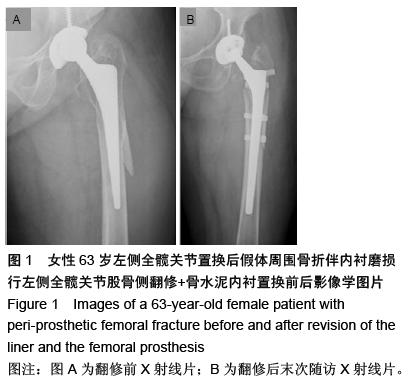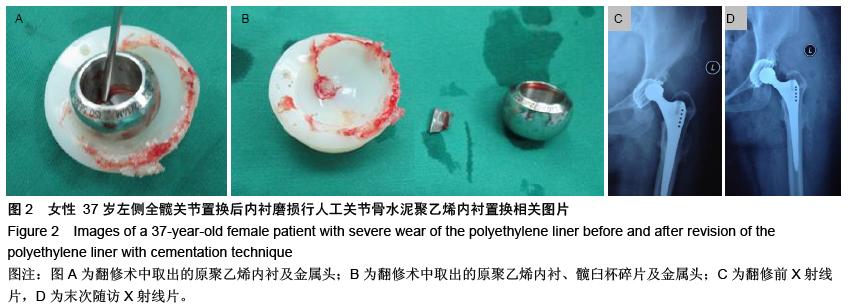| [1] Adelani MA, Mall NA, Nyazee H, et al. Revision Total Hip Arthroplasty with Retained Acetabular Component. J Bone Joint Surg. 2014;96(12): 1015-1020.[2] Ong KL, Mowat FS, Chan N, et al. Economic burden of revision hip and knee arthroplasty in Medicare enrollees. Clin Orthop Relat Res. 2006;446:22-28.[3] He C, Feng JM, Yang QM, et al. Results of selective hip arthroplasty revision in isolated acetabular failure. J Surg Res. 2010;164(2): 228-233.[4] Koh KH, Moon YW, Lim SJ, et al. Complete acetabular cup revision versus isolated liner exchange for polyethylene wear and osteolysis without loosening in cementless total hip arthroplasty. Arch Orthop Trauma Surg. 2011;131(11): 1591-1600.[5] Talmo CT, Kwon YM, Freiberg AA, et al. Management of polyethylene wear associated with a well-fixed modular cementless shell during revision total hip arthroplasty. J Arthroplasty. 2011;26(4): 576-581.[6] Mauerhan DR, Peindl RD, Coley ER, et al. Cementation of polyethylene liners into well-fixed metal shells at the time of revision total hip arthroplasty. J Arthroplasty.2008;23(6): 873-878.[7] Della Valle CJ, Mesko NW, Quigley L, et al. Primary total hip arthroplasty with a porous-coated acetabular component. A concise follow-up, at a minimum of twenty years, of previous reports. J Bone Joint Surgery Am. 2009;91(5): 1130-1135.[8] Sadoghi P, Liebensteiner M, Agreiter M, et al. Revision surgery after total joint arthroplasty: a complication- based analysis using worldwide arthroplasty registers. J Arthroplasty. 2013;28(8): 1329-1332.[9] Heck DA, Murray DG. In vivo construction of a metal-backed, high-molecular-weight polyethylene cup during McKee-Farrar revision total joint arthroplasty. A case report. J Arthroplasty. 1986;1(3): 203-206.[10] Beaule PE, Ebramzadeh E, Le Duff M, et al. Cementing a liner into a stable cementless acetabular shell: the double-socket technique. J Bone Joint Surg Am. 2004;86-A(5): 929-934.[11] Hofmann AA, Prince EJ, Drake FT, et al. Cementation of a polyethylene liner into a metal acetabular shell: a biomechanical study. J Arthroplasty. 2009;24(5): 775-782.[12] Haft GF, Heiner AD, Dorr LD, et al. A biomechanical analysis of polyethylene liner cementation into a fixed metal acetabular shell. J Bone Joint Surg Am. 2003; 85-A(6): 1100-1110.[13] Bonner KF, Delanois RE, Harbach G, et al. Cementation of a polyethylene liner into a metal shell. Factors related to mechanical stability. J Bone Joint Surg Am. 2002;84-A(9): 1587-1593.[14] Park MS, Yoon SJ, Lee JR. Outcomes of polyethylene liner cementation into a fixed metal acetabular shell with minimum follow-up of 7 years. Hip Int. 2014.[15] Rivkin G, Kandel L, Qutteineh B, et al. Long Term Results of Liner Polyethylene Cementation Technique in Revision for Peri-acetabular Osteolysis. J Arthroplasty. 2015;30(6): 1041-1043.[16] Lim SJ, Lee KH, Park SH, et al. Medium-term results of cementation of a highly cross-linked polyethylene liner into a well-fixed acetabular shell in revision hip arthroplasty. J Arthroplasty. 2014;29(3): 634-637.[17] Lie SA, Hallan G, Furnes O, et al. Isolated acetabular liner exchange compared with complete acetabular component revision in revision of primary uncemented acetabular components: a study of 1649 revisions from the Norwegian Arthroplasty Register. J Bone Joint Surg. 2007;89(5): 591-594.[18] Blom AW, Astle L, Loveridge J, et al. Revision of an acetabular liner has a high risk of dislocation. J Bone Joint Surg Br. 2005;87(12): 1636-1638.[19] Barrack RL. Dislocation after total hip arthroplasty: implant design and orientation. J Am Acad Orthop Surg. 2003;11(2): 89-99.[20] Tan TL, Le Duff MJ, Ebramzadeh E, et al. Long-Term Outcomes of Liner Cementation into a Stable Retained Shell: A Concise Follow-up of a Previous Report. J Bone Joint Surg Am. 2015;97(11): 920-924.[21] Callaghan JJ, Hennessy DW, Liu SS, et al. Cementing acetabular liners into secure cementless shells for polyethylene wear provides durable mid-term fixation. Clin Orthop Relat Res. 2012;470(11): 3142-3147.[22] O'Brien JJ, Burnett RS, Mccalden RW, et al. Isolated liner exchange in revision total hip arthroplasty: clinical results using the direct lateral surgical approach. J Arthroplasty. 2004;19(4): 414-423.[23] Stamenkov R, Neale SD, Kane T, et al. Cemented liner exchange with bone grafting halts the progression of periacetabular osteolysis. J Arthroplasty. 2014;29(4): 822-826.[24] Boucher HR, Lynch C, Young AM, et al. Dislocation after polyethylene liner exchange in total hip arthroplasty. J Arthroplasty. 2003;18(5): 654-657.[25] Restrepo C, Ghanem E, Houssock C, et al. Isolated polyethylene exchange versus acetabular revision for polyethylene wear. Clin Orthop Related Res. 2009; 467(1): 194-198.[26] Park MS, Yoon SJ, Lee JR. Outcomes of polyethylene liner cementation into a fixed metal acetabular shell with minimum follow-up of 7 years. Hip Int. 2015;25(1): 61-66.[27] Wang JP, Chen WM, Chen CF, et al. Cementation of cross-linked polyethylene liner into well-fixed acetabular shells: mean 6-year follow-up study. J Arthroplasty. 2010;25(3): 420-424. |
.jpg)


